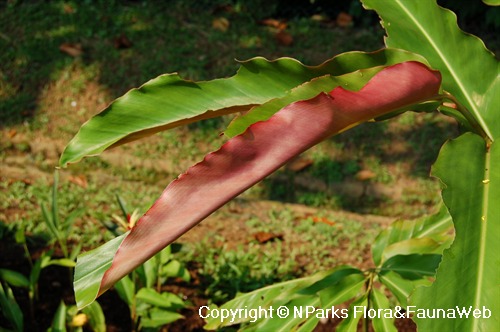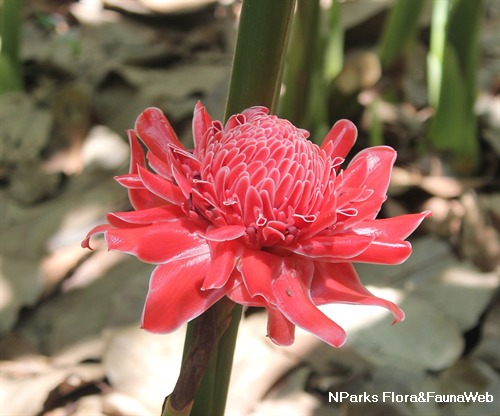
Back
Etlingera hemisphaerica (Blume) R. M. Smith
| Family Name: | Zingiberaceae |
| Synonyms: | Amomum hemisphaericum, Elettaria hemisphaerica, Phaeomeria hemisphaerica, Cardamomum hemisphaericum, Nicolaia hemisphaerica, Alpinia hemisphaerica |
| Common Name: | Helani Tulip Ginger, Helani Tulip Torch Ginger, Tulip Torch, Black Torch Ginger |
Name
Classifications and Characteristics
| Plant Division | Angiosperms (Flowering Seed Plants) (Monocotyledon) |
|---|---|
| Plant Growth Form | Herbaceous Plant |
| Lifespan (in Singapore) | Perennial |
| Mode of Nutrition | Autotrophic |
| Maximum Height | 3 m to 6 m |
Biogeography
| Native Distribution | Indonesia (Sumatra and Java), Peninsular Malaysia, Thailand |
|---|---|
| Native Habitat | Terrestrial (Primary Rainforest, Secondary Rainforest) |
| Preferred Climate Zone | Tropical |
Description and Ethnobotany
| Others - Plant Morphology | Growth Form: Rhizomatous perennial with leafy shoots that occur in clumps. Habitat: Occurs in primary and secondary forests at altitudes of up to 950 m. Stem: Stem is round and herbaceous. Foliage: Glossy, alternate leaves are oblong with a wavy leaf margin, rounded base and acute apex (80 cm long, 15 cm wide). Young foliage is green on top and dark red to purple on the underside. Mature foliage is green on both sides with sometimes a light reddish hue on the underside. Flowers: About 40 - 50 flowers are arranged in a cup-shaped or tulip-like inflorescence (~6 cm wide). Only a few flowers are open at any given time. The inflorescences are borne on floral stalks that lack leaves (0.5 - 0.6 m tall). Fruits: A group of 2 - 20 indehiscent fruits are fused together. Individual fruits are pubescent and globular with an apex that is flattened or a little depressed. The fruits are an important food source for rodents. Landscaping: This species is planted in parks and public gardens. It is also planted in home gardens, but one should consider the large size this species attains at maturity (3 - 6 m) before planting. This species has low salt tolerance, so avoid planting in beach settings. However, it can be grown in a pot indoors, because the smaller soil volume will result in a more compact plant. In Hawaii, this species is often used in landscaping. Cultivation: Plant in soil that is rich in humus. Protect plants from wind. When grown indoors, this species requires a humid environment and thorough watering. Propagation: Propagate by seed or by division of the rhizome. Etymology: The genus name "Etlingera" was named after A.E. Etlinger, a botanist of the 18th century who published an extensive description of the genus Salvia. The species epithet "hemisphaerica" means hemispherical. It likely refers to the cup-shaped inflorescence. |
|---|---|
| Ethnobotanical Uses | Edible Plant Parts : Edible Leaves, Edible Stems Food (Fruit or Vegetable) Others: Food: Inflorescences and fruits (both unripe and ripe) are consumed raw or cooked. The leafy shoots are also edible. |
Landscaping Features
| Desirable Plant Features | Ornamental Flowers |
|---|---|
| Landscape Uses | General, Container Planting |
Fauna, Pollination and Dispersal
| Seed or Spore Dispersal | Biotic (Fauna) |
|---|
Plant Care and Propagation
| Light Preference | Full Sun, Semi-Shade |
|---|---|
| Water Preference | Lots of Water |
| Plant Growth Rate | Fast to Moderate |
| Rootzone Tolerance | Fertile Loamy Soils, Well-Drained Soils |
| Propagation Method | Seed, Division |
Foliar
| Mature Foliage Colour(s) | Green |
|---|---|
| Mature Foliage Texture(s) | Smooth, Glossy / Shiny |
| Foliar Type | Simple / Unifoliate |
| Foliar Arrangement Along Stem | Alternate |
| Foliar Shape(s) | Non-Palm Foliage (Oblong) |
| Foliar Venation | Parallel |
| Foliar Margin | Entire - Wavy / Undulate |
| Foliar Apex - Tip | Acute |
| Foliar Base | Rounded / Obtuse |
| Typical Foliar Area | Macrophyll ( 182.25cm2 - 1640.25 cm2 ) |
Non - Foliar and Storage
| Stem Type & Modification | Herbaceous |
|---|---|
| Root Type | Underground (Fibrous Root) |
Floral (Angiosperm)
| Flower Colour(s) | Pink, Red |
|---|---|
| Individual Flower Shape | Bowl-shaped |
| Flower Size - Remarks | 6 cm |
Image Repository
Others
| Master ID | 30634 |
|---|---|
| Species ID | 4943 |
| Flora Disclaimer | The information in this website has been compiled from reliable sources, such as reference works on medicinal plants. It is not a substitute for medical advice or treatment and NParks does not purport to provide any medical advice. Readers should always consult his/her physician before using or consuming a plant for medicinal purposes. |




.jpg)

